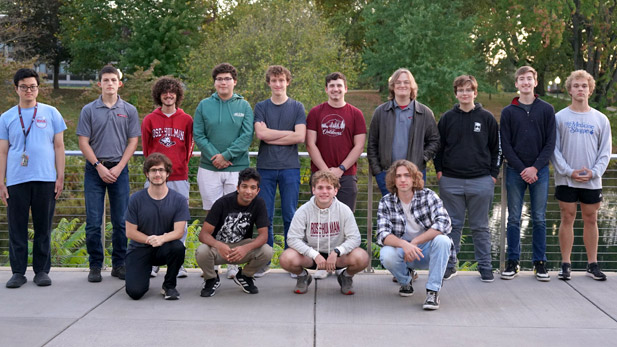Rocketry Propulsion Group Launches Collegiate Lander Challenge Effort

The Rose Propulsion Laboratory has students developing a self-landing rocket for the Collegiate Propulsive Lander Challenge. The first steps were completed this school year, but there’s still time for students to join the effort.
A group of Rose-Human students are taking their interests in rocket propulsion to new heights by developing elements of self-landing rockets – in hopes of duplicating the successes of professional spacecrafts launched by SpaceX and Blue Origin – while competing in a unique collegiate rocketry challenge.
The Rose Propulsion Laboratory, a liquid rocket exploration initiative of the Rose Rocketry Club that involves nearly 20 students, is among a growing list of international colleges and universities teams participating in the Collegiate Propulsive Lander Challenge (CPLC). The four-year competition strives to “drive elite collegiate rocketry teams to execute on self-landing rockets,” according to the challenge’s website.
The challenge consists of five distinct milestones, culminating with a lander vehicle, carrying a 30-pound payload, that takes a flight exceeding 150 feet before propulsively landing to the ground on its main engine, without parachutes, tethers, or other technology. The rocket has an engine that’s capable of producing more than 500 pounds of force.
Rose-Hulman’s team involving students from several different academic majors has started testing its second engine, an 80-pound bipropellant unit fueled by ethanol and nitrous oxide. Meanwhile, work is also underway on the development of a more powerful, third-generation engine that will be used in the competition. This engine will produce over 500 pounds of thrust by burning isopropyl alcohol and nitrous oxide. Further advancements in burn time and performance are achieved through more advanced architecture and the use of metal 3D printing.
“What we’re trying to do is quite ambitious for a collegiate team, but we’re making great progress in our first year. There’s more room to grow and we hope to expand the team in the future as more students get on board. There’s a lot of interest in all aspects of rocket development on campus – from engines to launch systems to flight control to returning safely to the launch pad,” said co-team leader Vann Wellmon, a mechanical engineering student.
The other team leader is Cassie Domke, also a mechanical engineering major. The team currently consists of juniors, sophomores, and first-year students. The team’s faculty mentor of Elaine Kirkpatrick, PhD, associate professor of physics and optical engineering.
CPLC is operated by the Definity Project and partners include Stoke Space, Impulse Space, Astrobotic, the Spaceport Company, and Friends of Amateur Rocketry, along with having a variety of industry partnerships, including the Musk Foundation.
Joining Rose-Hulman in having competing teams are University of California Berkeley, University of California San Diego, California Polytechnic Pomona, California Polytechnic San Luis Obispo, Embry Riddle University (Florida), University of Florida, Florida International University, University of Minnesota, Monash University (Australia), Purdue University, Stanford University, and Texas A&M University.